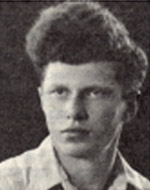Moshe, the son of Tirza and Zvi, was born on May 17, 1930 in Lodz, Poland. Born to a devout family, his father was a certified accountant and a trade unionist. Moshe attended elementary school in his city. Lodz was occupied by the Germans on September 8, 1939, a week after the beginning of World War II. Immediately after its annexation to the German Reich, cruel persecutions of Jews began, abductions of slave labor and abuse. The economic and social life of the city’s Jews collapsed and they were required to wear a yellow badge. On February 8, 1940, a ghetto was set up in Lodz, where the transfer of Jews was accompanied by an increase in violence. The ghetto was closed in April and about 200,000 men, women and children were crammed into it under inhuman conditions. The Jews of the ghetto were exploited as cheap labor and forced to work in production plants for the Germans. The ghetto soon became a site of mass mortality: overcrowding and poor sanitary conditions caused epidemics, and the population suffered from starvation and starvation. In 1942 about 80,000 ghetto residents were sent to the Chelmno death camp. The Lodz ghetto, which was the last to be held in Poland, was liquidated in the spring of 1944. For this purpose, the Chelmno extermination camp was reopened, and Jews were deported under the guise of deportations to labor camps in Germany. From August 1944 all the remaining Jews were deported to the Auschwitz death camp. Moshe and his family were also interned in the ghetto. In the first year of the war, Moshe was still visiting the school, but was soon sentenced to work hard. His brother, nine years his junior, perished together with his parents in the Auschwitz camp. Only Moshe held on to the coal mine, and he got to the day of liberation. In 1946, Moshe immigrated to Eretz Israel with the Youth Aliya – the Jewish Agency’s project to bring children and youth to Israel, to absorb them and rehabilitate them in communities and institutions and prepare them for working and agricultural life. He arrived in Jerusalem and was absorbed in the youth group at the “Aliyat Hanoar” study farm and was Simcha. Later he was sent as a member of Hashomer Hatzair for training in Kibbutz Gan Shmuel, north of Hadera. Moshe became acquainted with the world of agriculture, worked as a coward and found great satisfaction in this profession. His friends remember that all his spare time was devoted to reading – especially of world literature – and then he was eager to give his impressions of his reading. At the outbreak of the War of Independence, Moshe was drafted and served as a gunner until the end of the war. Mainly in the south, in the area of the Iraqi authorities of Al-Manshia and Falluja. He took an active part in the defense of Kibbutz Gat (north of Kiryat Gat). “He was not afraid of death and knew how to dispel his terror with amusement, although not easily,” his friends say. “He knew how to act seriously in every way he went.” At the end of the war he decided to continue his career in the army, in the Artillery Corps. He served in the Sdeh battalion, passed a course for deputy team commanders and within a year he was promoted to the rank of artillery sergeant. As commander of an artillery crew, he was known for his concern for the safety and fate of his subordinates, and was loved and accepted by everyone. His commanders recognized his skills and recommended his departure for the officers’ course, but Moshe planned to finish his service and return to the kibbutz. On the 25th of Cheshvan 5712 (25.11.1951) Moshe was killed in the course of his duty in a traffic accident on the Har Tuv road. Twenty-one years old. Moshe was laid to rest in the cemetery at Kibbutz Gan Shmuel. After his fall he was promoted to the rank of sergeant. His commander eulogized him: “… he excelled as a commander, and his mood was always elevated, even in the most difficult moments of operations or exercises … Moshe was at all times a living figure of the pioneering youth.” In recognition of the commander and the man, and to commemorate his beloved figure, the battalion’s culture room was named after him. Moshe’s kibbutz, Gan Shmuel, published a pamphlet in his memory. This hero is a “last scion”. The last survivor of the Holocaust is Holocaust survivors who have survived the last remnant of their nuclear family (parents, brothers, sisters, sons and daughters) who have lived onIn the camps and / or in the concentration and death camps and / or in hiding and hiding in the territories occupied by the Nazis and / or fighting alongside members of the underground movements or partisans in Nazi-occupied territories who immigrated to Israel during or after World War II,
